Diplladies or Mandeville are two officially recognized names of one plant - the most beautiful liana with spectacular bright and long flowering. Caring for dipladenia at home is simple, but there are some important points without the knowledge and application of which it is impossible to achieve high decorativeness of this plant.
Material Content:
Diplomats: popular flower varieties
The genus of Diplomacy unites about 200 species of climbing or clinging evergreen vines, numerous varieties of which are grown as garden, greenhouse or indoor crops. The most popular are 5 of them.
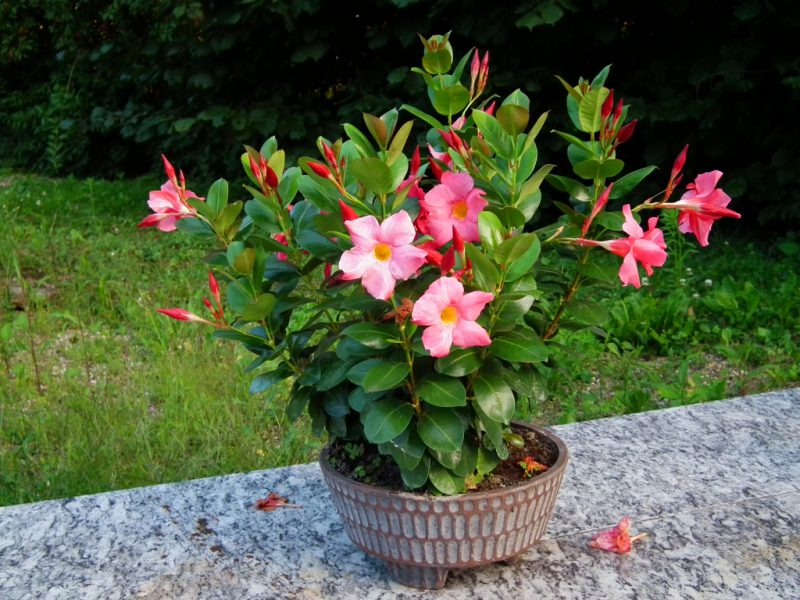
- Mandeville is brilliant. This is a spectacular ampelnik, grown at home, with long (3-5 m), pubescent in a young state and bare in a mature shoot. Branches covered with large (up to 20 cm) leaves of ellipsoid shape, with a wide heart-shaped base and a pointed apex. The underside of the leaf blades is pubescent. It blooms, forming racemose inflorescences of 3–6 large bright orange on the outside and white inside the funnel-shaped buds, surrounded by red bracts.
- Diplomacy Bolivian. It differs from its relatives in smooth shoots that carry small (up to 4 cm) oval glossy leaves. The flowers are axillary, medium in size (about 5 cm), collected in racemose inflorescences of 3-4 pieces. Corollas are painted in white color. Pharynx of yellow shades.
- Mandeville is excellent. An elegant vine with thin, smooth or slightly pubescent pinkish shoots that carry small (up to 4 cm) rounded leaves.Large flowers of red shades are distinguished by a long (5 cm) corolla tube.
- Diplomas of Sander. A very common species with smooth shoots bearing dense pointed leaves of emerald shades. Flower brushes are formed 3-5 bright, pink with yellow pharynx, corollas.
- Diplomacy loose. It differs in powerful, fast-growing branching warty shoots, stretching to a length of 6-7 m. The leaves are large (up to 15 cm) gray-green, ovate, with slight pubescence on the underside. Small (up to 5 cm in diameter) flower corollas are painted white or cream and are very fragrant. This species, due to its impressive size, requiring appropriate space, is kept in greenhouses.
Comfortable growing conditions
For good growth and development of diplomacy, you need:
- warm: in summer - 20-25 ° C, in winter enough from 12 to 15 ° C;
- light: bright, but diffused or with dimming in the afternoon hours;
- moist (70%) air.
Home Care
Cultivation of diplomacy in room conditions is not difficult.
The main care measures are: watering, top dressing, pruning and transplanting.
Watering
Moistening mode is determined by the characteristics of the seasonal vegetation of creepers
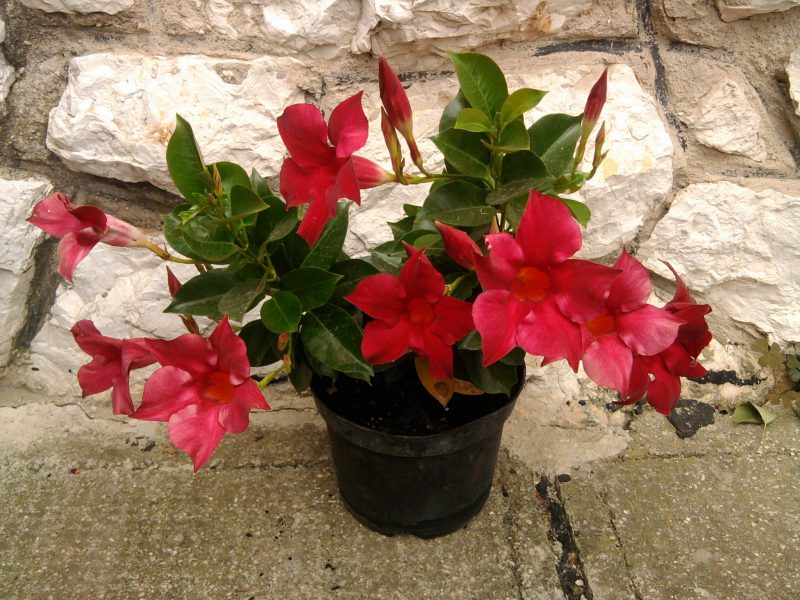
- In spring and summer, during the active growth of the ground part, as well as during flowering, the flower is watered regularly and abundantly. The soil should always be slightly moist.
- In autumn, humidification is carried out less frequently and only when the upper (1-2 cm) layer of soil is completely dry.
- In winter, the moisture level is lowered and watered the plant no more than 1 time per month.
Humidification and spraying of mandeville is carried out with standing or pre-boiled water, slightly acidified with food acid.
Top dressing
From spring (April-March) to autumn (September), the vine is supported by complex mineral additives for decorative flowering plants. Fertilizers are applied once every 2-3 weeks.
Pruning
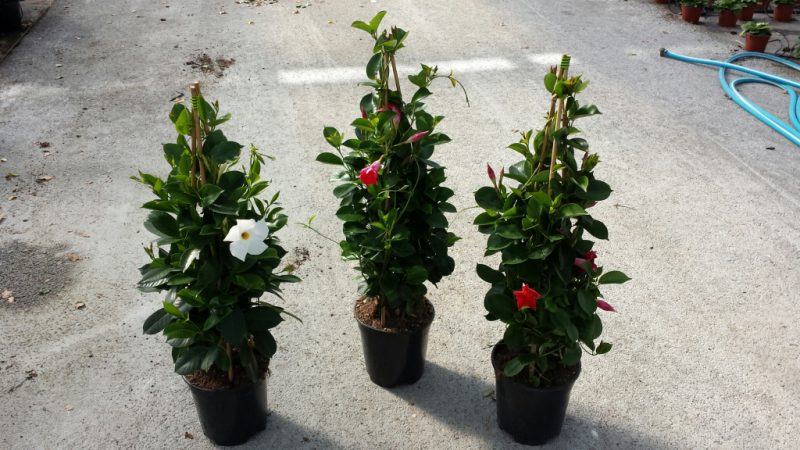
Dipladenia forms buds only on young branches, therefore, in the fall, at the end of October, November, its shoots are cut off, shortened by 2/3 of the length. In this state, the plant tolerates wintering more easily and develops more actively in the spring.
Transfer
Young fast-growing forms are transplanted annually. Adults - as necessary, which is determined by filling the containers with roots.

- Pot selection. The diplomats do not like crowding, therefore wide, but not too deep containers with a good drainage compartment and openings for water drainage are chosen for its cultivation.
- Recommended soil composition. Mandeville prefers a nutritious, light and slightly acidic substrate. It can be purchased at the store or compiled independently, using equal amounts of sand, turf and sheet land, with the addition of 1 part humus and coarse sand for every 2 parts of this mixture. You can use another mixture - from turf and leafy soil, humus and sand, taken in a ratio of 2: 1: 1: 1.
Transplantation sequence
Lianas are transplanted carefully, by transshipment method.
For this:
- at least 1 hour before the procedure, the plant is watered abundantly;
- carefully, together with the ground, removed from the old pot;
- conduct a surface inspection of the roots, removing all visible rotted areas;
- a drainage layer is laid at the bottom of the new tank, 1/3 of the soil mixture is placed on it.
- an earthen lump is installed in the center of the pot, the voids are covered with a substrate, slightly compacting it.
During the transplant, a support is installed, in which quality wooden or plastic lattices and figured structures are suitable.
The transplanted vine is watered abundantly and darkened for several days.
Plant propagation
A diplomatic flower propagates by seed and vegetatively.
At home, they prefer vegetative propagation, most often using cuttings.
Cuttings
Harvesting cuttings begin in mid-spring, during the active growth of apical and lateral shoots.
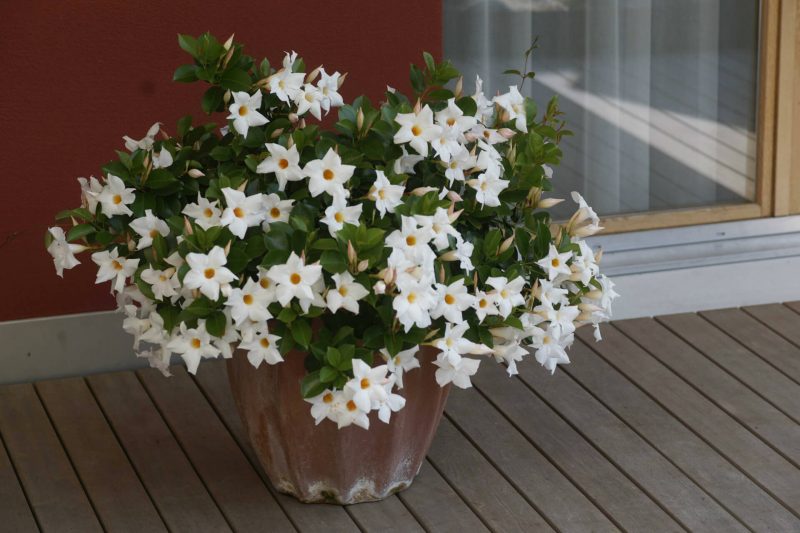
For this:
- cut off the upper parts (10-15 cm) of young shoots at an angle;
- the lower pair of leaves is removed;
- sections on the maternal cortex are treated with crushed coal, on the handle - with any drug that stimulates root formation.
Root growth is carried out in water or substrate.
A compromise option is to place the cuttings in a vessel with water until a callus forms on them (an influx in the lower part), which takes about 3 weeks.
- After that, without waiting for the roots to grow, the cuttings are planted in a moist substrate (equal parts of peat and sand with the addition of a small amount of dry moss) and buried to the bottom pair of leaves.
- Greenhouse conditions are organized for young creepers by covering with transparent, airtight material.
- All this time the plantings are kept warm (25 ° C), in good light, ventilated daily and make sure that the soil is slightly moist.
The formation of new leaves and shoots testifies to complete rooting. As soon as this happens, the protection is removed. After 2-3 weeks, the young diplladies are transplanted in separate pots to a permanent place with the simultaneous installation of support. Its height should be 1.5-2 times the length of the shoots.
In the vast majority of cases, the grafting of mandeville is successful. The exception is terry varieties, the cuttings of which are very poorly rooted. Most terry species have clinging shoots ending in antennae that can be rooted.
Antenna propagation
This method of obtaining new plants, in comparison with the cuttings, is simpler, but less effective.
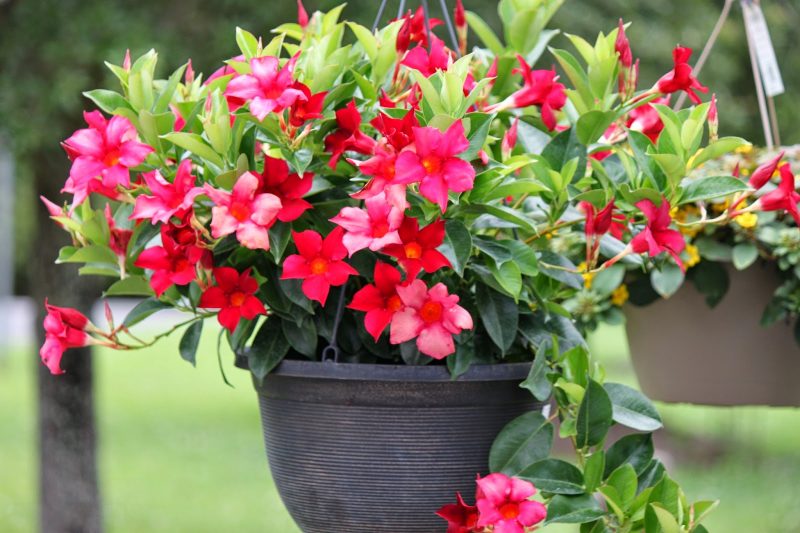
To implement you need:
- bend the top of the shoot to the surface of the soil;
- to fix or pin it in the place of growth of the antennae;
- be patient and wait for rooting.
The rooted shoot is separated from the maternal form and planted in a new permanent place.
Seed propagation
Reproduction of mandeville seeds is difficult and time-consuming, but allows you to get rare varietal forms or their own hybrids.

- Where to get and how to prepare the seeds. They can be found on sale. They cost not cheaply - from 40 to 50 rubles. for 1 seed. Self-collection of planting material will avoid these costs. Seeds are long (4-6 months) and sprout unfriendly, so before sowing they are soaked in a warm solution of a rooting agent, for example, Epin.
- Sowing. It is carried out in shallow containers, pre-filled with a pre-sanitized, light, slightly acidic substrate, consisting of 1 part sand mixed with ½ part peat. Before sowing, the soil is moistened. Seeds are evenly distributed on the surface of the soil, sprinkled with earth and moisten again.
- Seedling care. Weak seedlings of diplladation need careful care. With the advent of most of them, the protection from the container is removed. The container is placed in a warm (25 to 28 ° C) and bright place, protected from direct sunlight and regularly watered. After the appearance of the first pair of true leaves, seedlings dive into separate small containers.
When shoots grow to a length of 10 cm, young vines of several pieces (2-3) are transplanted into pots in a permanent place and taken care of as adult forms.
Pest and Disease Control
Diplomacy is resistant to pests and rarely gets sick.
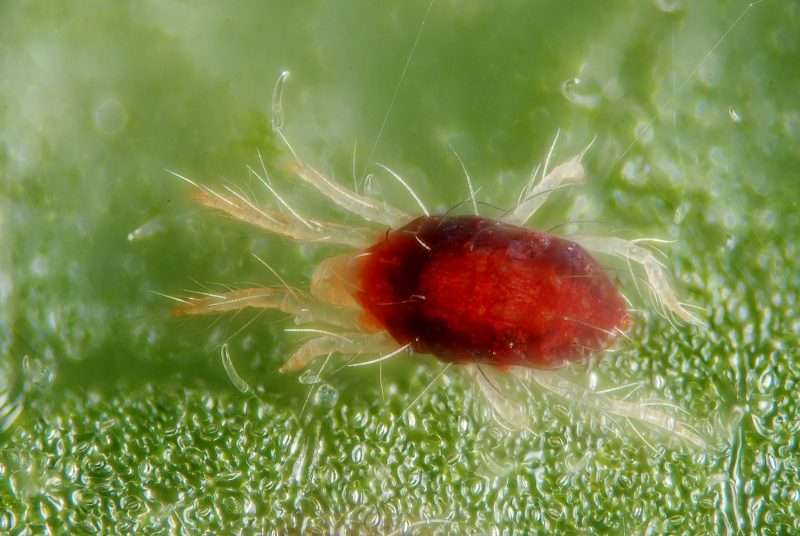
However, young, fragile and weakened by improper care vines can still be affected by sucking insects: aphids, spider mites and scale insects.
- The defeat of aphids is diagnosed by discoloration and twisting of leaves with subsequent deformation of the shoots. In this case, the leaves of the creeper are repeatedly treated with a soap solution, leaving it to dry, then the leaf blades are washed under a stream of warm water. In case of low effectiveness of the measures taken or in case of severe damage, insecticides are used.
- The spider mite is manifested by the formation of a thin cobweb between the shoots, as well as drooping, and then yellowing and falling leaves.As an emergency aid, the plant is given a warm shower with subsequent treatment of the shoots with systemic insecticides (Fitoverm, Derris). Preventive measure - regular spraying of the plant (the tick develops only in dry air).
- Scabies in the form of small dense and round formations are located on the underside of the leaves. They are cleaned with a soft, moist material, and then all the shoots are treated with an insecticide. These actions are carried out repeatedly until a complete victory over the pest.
- The roots of mandeville are affected by microscopic worms - nematodes. As a result of their life activity, the color of the liana gradually fades, its growth and development slows down. On the horses, a rounded form of swelling is formed - the places of dislocation of parasitic worms. Deformed sections are removed, and the remaining parts are placed for 30 min in a container with hot water, then dried. Slices sprinkled with crushed charcoal and planted in a new, pre-sanitized soil. Soil disinfection will help to avoid nematode damage before using it.
The main problems when growing
Dissatisfaction with the departure or violation of the conditions for the maintenance of mandeville shows a change in the appearance of the leaves and a decrease in the quality of flowering.

For example:
- When grown in dry air, the leaves of the creeper fade and curl. The buds, not having time to open, crumble.
- The causes of yellowing of leaves and discharge of flowers can be low (up to +12 ° C), especially in winter, air temperature, prolonged summer heat and waterlogging of the soil.
- In case of insufficient lighting, the brightness of the color of the leaves and flowers decreases. Under the influence of direct sunlight, the buds become smaller, dark spots of burns appear on the surface of the leaves.
- The uncharacteristic slow growth and development of creepers is evidence of an improperly selected substrate or lack of nutrients.
For the care and attention of diplomacy, he will thank his owners with bright blooms lasting all summer.












